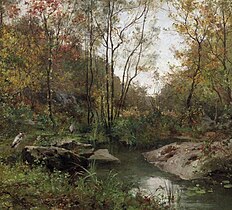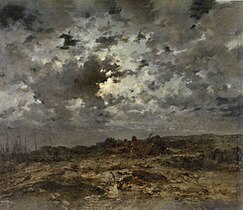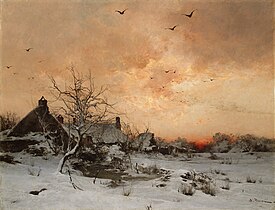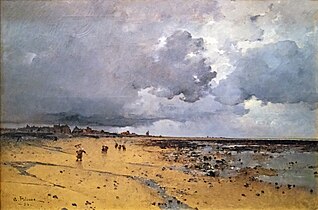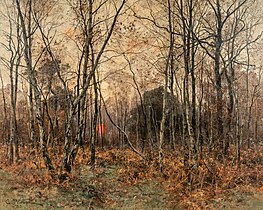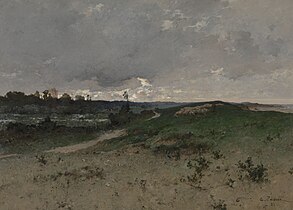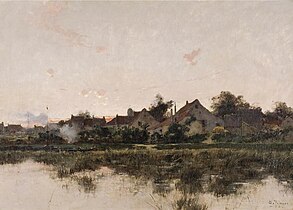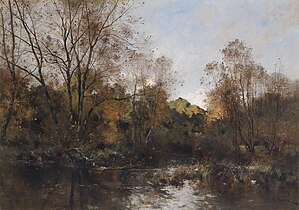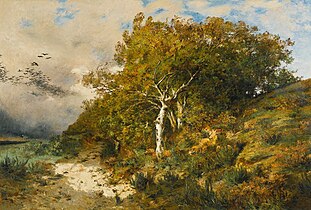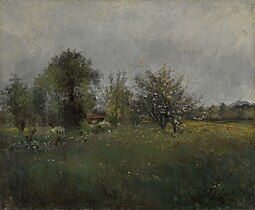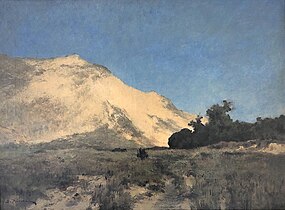Léon Germain Pelouse
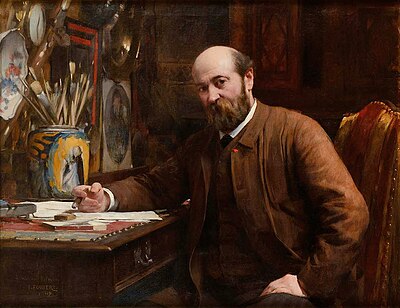
Léon Germain Pelouse (1 October 1838 – 31 July 1891) was a self-taught French painter born in Pierrelaye (Val-d'Oise, France),[1] who became one of the leading landscape painters of France in the last half of the 19th century.
Life and career
At sixteen, he began working as a traveling salesman. He began painting when he was twenty, as he was serving in the French army as a conscript.[2] His professional painting career began at twenty-seven, with the exhibition of his Les Environs de Précy (Near Précy) at the Salon de Paris of 1865.[3] He moved to Brittany, and there, inspired by nature around Pont-Aven and Rochefort-en-Terre, Pelouse painted landscapes which were exhibited at the Salon de Paris in the following years. From 1873, when he received his first medal, for Vallée de Cernay,[4] he gained success and critical approval.
The French government bought many of his works which are now in the collections of numerous museums, including the Musée d'Orsay,[5] the Musée Malraux, and the Musée des Beaux-Arts de Nantes.[6] His works are also held in the Metropolitan Museum in New York, and in museums in San Francisco, Ghent, Oslo, Munich, and Sydney.
École de Cernay; students

During the Franco-Prussian war of 1870, Pelouse enlisted as a National Guardsman. During his serivce, he spent time in the town of Cernay-la-Ville, near Paris, and was drawn to the surrounding scenery. In 1871, Pelouse moved to Cernay, boarding at the inn of Léopold Lequesne. 1876, with his wife and stepson, he rented a small house on the village square.[7]
Pelouse was visited by other artists and attracted an international coterie of pupils, who socialized in the welcoming inns of Place de Cernay-la-Ville, in particular the establishment of Léopold Lequesne, which became known as Au Rendezvous des Artistes.[8][9] Pelouse and this colony of colleagues and students become the École de Cernay, of which Pelouse was the acknowledged chef de file.[10]
Paradoxically, the self-taught Pelouse became the mentor and teacher of many painters, who came from as far as Sweden and Canada to study and paint outdoors with him in the fields and woods outside Cernay-la-Ville. These included Madame Annaly, Érnest Baillet, Harriet Backer, Charles Émile Dameron, Nicolas Dracopolis, Allan Edson, Eugène Galien-Laloue, Léon Joubert, Kitty Lange Kielland, Adolphe-Frédéric Lejeune, Émile Le Marié des Landelles, Flavien-Louis Peslin, Albert Rigolot, Louis Telingue, and Percy Franklin Woodcock.[11][12][13][14][15]
Pelouse welcomed female artists, including Norwegian Kitty Lange Kielland and her compatriot and friend Harriet Backer. They accompanied Pelouse on an excursion to Rochefort-en-Terre, in Brittany. Backer later recalled: "Léon Pelouse had proposed to us two women that we spend the summer in his company in a location he had discovered and kept secret: it was a way of getting a jump on new and original subjects, instead of the well-worn themes exhibited at the Salon...Under a discreet disguise, we set out with Pelouse, his wife, and two of his male pupils." She added: "Pelouse is the most natural man I've ever met...I'm sure if you were to arrive one evening while we're at the table, you'd be extremely surprised. Pelouse and Érnest Baillet each scream louder than the other to make themselves heard, to the point that one wonders if they'll come to blows—then it all ends with outbursts of laughter, so loud we have to cover our ears."[16]
In the spring and summer of 1879, the Danish painter P.S. Krøyer stayed at Pelouse's home in Cernay, and painted Le Déjeuner des artistes à Cernay-la-Ville, which captures the social scene at Léopold inn. Pelouse can be seen standing at right, smoking, framed by the glow of light from the window.[17][18]
Other locations
While based in Cernay, Pelouse made numerous excursions to paint the scenery at Pont-Aven, Rochefort-en-Terre Concarneau, Honfleur, Trouville, Marlotte in the Forest of Fontainebleau, and beyond France to Belgium and Holland.[9]
In 1884, the Pelouse family left Cernay to return to Paris. Between 1886 and 1888, the artist painted near Besançon, in the Loue valley dear to Gustave Courbet. About sixty paintings date from this period.[9]
Family

After the death of her husband Ernest Raingo in 1871 (and by 1876[19]), his widow, née Lucy-Alexandrine Fossey (1842-1895), married Pelouse. Raingo's sister Angélique was the wife of Claude Monet.
In 1890, in failing health, Pelouse officially adopted Lucy's son by Raingo, Jean, who took the name Raingo-Pelouse.[20] Jean's sons Germain, Bernard and Pierre also took this name. Germain Raingo-Pelouse (1893-1963) became a noted artist, but never knew his grandfather and namesake. (Their lifespans did not overlap).[21] Claude Monet was his granduncle.
Gallery
-
Le Plateau de la Montjoie à Mortain, 1872, Musée d'Orsay
-
La Vallée de Cernay, 1873, Musée Musée des Beaux-Arts de Dunkerque
-
La Mare aux hérons (detail), before 1875, private collection
-
Une Coupe de bois à Senlisse, 1876, Pierrelaye town hall
-
Le passage de Lanriec à Concarneau, effet de lune, 1878, Musée des Beaux-Arts de Rouen
-
Un coin de Cernay en janvier, after 1879, by 1887, Metropolitan Museum
-
Banc de rochers à Concarneau, 1880, Musée des Beaux-Arts de Brest
-
Landscape with storm clouds, 1881, private collection
-
Grandcamp à marée basse, 1884, Musée des Beaux-Arts de Carcassonne
-
Forest at dusk, 1885, private collection
-
Paysage dans les environs de Saint-Jean-le-Thomas (Normandie), 1885, Museum of Fine Arts Ghent
-
Riverside village at dusk, 1888, private collection
-
Étang forestier, n.d., private collection
-
Forêt de Fontainebleau, n.d., private collection
-
Landscape, n.d., NaM, Oslo
-
Mountain and dune, n.d., private collection
References
- ^ Champlin, "Pelouse, Léon Germain"
- ^ Grand Palais, p.148.
- ^ Fresneau, p. 99.
- ^ Jules Claretie, Peintres et sculpteurs contemporains, Paris, Charpentier, 1874, p. xi.
- ^ Musée d'Orsay, Aux couleurs de la mer : Paris, Musée d'Orsay, 6 novembre 1999-16 janvier 2000, Paris, Réunion des musées nationaux, 1999, p. 65.
- ^ "Pelouse Léon Germain", Portail des collections des musées de France, Paris, Joconde, 2013
- ^ de Lassus, pp. 41-42
- ^ Dutat, p. 24-25.
- ^ a b c de Lassus, p. 42.
- ^ de Lassus, p. 40.
- ^ de Lassus, p. 43.
- ^ "Léon Germain Pelouse". association-peintres-en-vallee-de-chevreuse.fr. Retrieved December 30, 2023.
- ^ Sicotte (2002), p. 22.
- ^ Sicotte (2005), p. 117.
- ^ Béland (2017).
- ^ Dutat, p. 25.
- ^ Aas, Tanja (August 9, 2022). "Close to: Léon Germain Pelouse (1838-1891)". skagenskunstmuseer.dk.
- ^ Regarding the location depicted, see Dutat, p. 25.
- ^ de Lassus, p. 42.
- ^ "Adoption", Le Droit: journal des tribunaux, November 5, 1890, p. 1057: "La première chambre de la Cour d’appel, présidée par M. Périvier, premier président, a confirmé le jugement du Tribunal de la Seine, portant qu'il y a lieu à l’adoption de Lucien-Jean-Léon Raingo, par Germain-Léon Pelouse."
- ^ "Généalogie familiale développée par Jean Raingo-Pelouse," Le Gaulois, August 4, 1908.
Sources
- Béland, Mario. "Woodcock et la paysannerie française", Cap-aux-Diamants: la revue d'histoire du Québec, no. 129, 2017, p. 53.
- Champlin, John Denison. Cyclopedia of painters and paintings, New York: Scribner, 1892.
- de Lassus, Priscille. "Pelouse, Chef de File" in Vallée de Chevreuse: le Petit Moulin des Vaux de Cernay, L'Object d'Art Hors-Série no. 106, Dijon: Éditions Faton, Sept. 2016, pp. 40–43.
- Dutat, Dimitri. "La colonie de Cernay, trois générations d’artistes" in Vallée de Chevreuse: le Petit Moulin des Vaux de Cernay, L'Object d'Art Hors-Série no. 106, Dijon: Éditions Faton, Sept. 2016, pp. 20–27.
- Fresneau, Estelle. Pont-Aven : du paysage à l'œuvre, Pont-Aven: Musée de Pont-Aven, 2007.
- Grand Palais. Le Musee du Luxembourg en 1874. Peintures, Paris: Grand Palais, 1974.
- Harambourg, Lydia. Cernay, une étape pour les paysagistes de Barbizon, catalogue on the exposition at the Centre Culturel Léon-Germain Pelouse de Cernay-la-Ville, 1997.
- Lanöe, Georges. Histoire de l'école française de paysage depuis Chintreuil jusqu'à 1900, Nantes: Société nantaise d'éditions, 1905.
- Levesque, Patrick and Stéphan, Édouard. Léon Germain Pelouse, 1838-1891, Catalogue Raisonné, Cernay-la-Ville: Chez l'Auteur, 2005.
- Montrosier, Eugène. Les artistes modernes, vol. 4, Paris: H. Launette, 1884, p. 63, pp. 101-104 and 1 unnumbered plate (Janvier à Cernay).
- Sicotte, Hélène (2002). Le Rôle de la Vente Publique dans l'Essor de Commerce et d'Art à Montréal au XiXe Siècle: Le cas de W. Scott & Sons ou comment le marchand d'art supplanta l'encanteur", Journal of Canadian Art History/Annales d'histoire de l'art Canadien, Vol. 23, No. 1/2, 2002, pp. 6-33.
- Sicotte, Hélène (2005). "Suzor-Coté chez W. Scott & Sons de Montréal: Du rôle de l'exposition particulière dans la consécration d'une carrière d'artiste", Journal of Canadian Art History/Annales d'histoire de l'art Canadien, Vol. 26, 2005, pp. 108-125.
- Schubert, Philippe and Schubert, France. Les peintres de la Vallée de Chevreuse, Paris: Éditions de l’Amateur, 2001.
External links
- Léon Germain Pelouse at cernaylaville.fr


